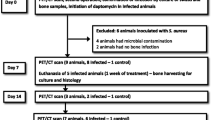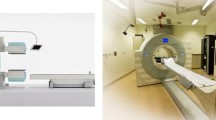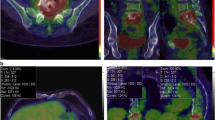Abstract.
The aim of this study was to evaluate the clinical use of fluorine-18 fluorodeoxyglucose positron emission tomography (FDG-PET) in acute and chronic osteomyelitis and inflammatory spondylitis. The study population comprised 21 patients suspected of having acute or chronic osteomyelitis or inflammatory spondylitis. Fifteen of these patients subsequently underwent surgery. FDG-PET results were correlated with histopathological findings. The remaining six patients, who underwent conservative therapy, were excluded from any further evaluation due to the lack of histopathological data. The histopathological findings revealed osteomyelitis or inflammatory spondylitis in all 15 patients: seven patients had acute osteomyelitis and eight patients had chronic osteomyelitis or inflammatory spondylitis. FDG-PET yielded 15 true-positive results. The tracer uptake correlated with the histopathological findings in each case. Bone scintigraphy performed in 11 patients yielded ten true-positive results and one false-negative result. Follow-up carried out on two patients revealed normal or clearly reduced tracer uptake, which correlated with a normalisation of clinical data. In early postoperative follow-up it was impossible to differentiate between postsurgical reactive changes and further infection using FDG-PET. It is concluded that acute and chronic osteomyelitis of the peripheral as well as the central skeleton can be detected using FDG-PET. Osteomyelitis can be differentiated from soft tissue infection surrounding the bone. Unlike computed tomography and magnetic resonance imaging, FDG-PET is not affected by metal implants used for fixing fractures. FDG-PET demonstrated promising initial results with respect to treatment monitoring. Nevertheless, in the early postoperative phase FDG-PET seems to be of limited value owing to unspecific tracer uptake.
Similar content being viewed by others
Author information
Authors and Affiliations
Additional information
Received 4 November 1999 and in revised form 20 January 2000
Rights and permissions
About this article
Cite this article
Kälicke, T., Schmitz, A., Risse, J. et al. Fluorine-18 fluorodeoxyglucose positron emission tomography in infectious bone diseases: results of histologically confirmed cases. Eur J Nucl Med 27, 524–528 (2000). https://doi.org/10.1007/s002590050538
Issue Date:
DOI: https://doi.org/10.1007/s002590050538




